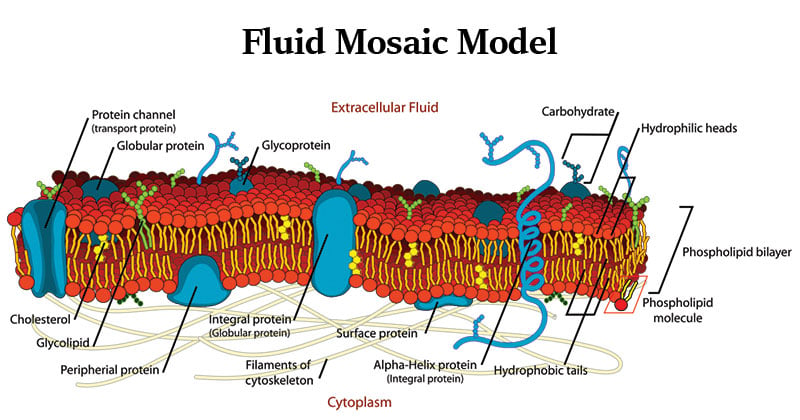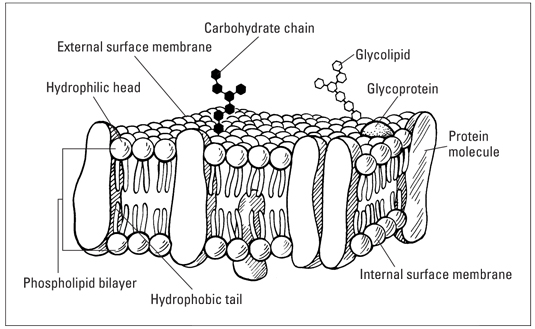Describe the Structure of Plasma Membrane Using Fluid Mosaic Model
Plasma membranes range from 5 to 10 nm in thickness. For comparison human red blood cells visible via light microscopy are.

A Fluid Mosaic Model Of The Cell Membrane Membrane Proteins Are Download Scientific Diagram
According to their model cell 3 membranes are composed of a lipid bilayer with globular proteins embedded in the bilayer.

. Phospholipids extrinsic proteins and intrinsic proteins. The proportions of proteins lipids and carbohydrates in the plasma membrane are different. Phospholipids and oligosaccharides B.
The fluid mosaic model is a model of the cell membrane that explains how the components are able to move freely laterally in the bilayer and that the membrane is able to flex and bend with the. The plasma membrane is a semi permeable barrier that separates the inside of the cell from the outside environment. The plasma membrane may be known as a fluid mosaic model where the membrane is a fluid structure with various proteins.
The description of the structure of plasma membrane can be carried out through the fluid mosaic model as a mosaic of cholesterol carbohydrates proteins and phospholipids. Phospholipids and integral proteins D. The fluid mosaic model is a model of the cell membrane.
Passive transport The plasma membrane is a semi permeable barrier that separates the inside of the cell from the outside environment. The fluid mosaic model is a model of the cell membrane. The fluid music model describes the structure of the plasma membrane as a music of components including forceful lipids cholesterol proteins and carbohydrates that gives the membrane a fluid director proportions of proteins lipids and carbohydrates in the plasma membrane very very vivid cell type.
-proteins and other membrane components are embedded in the membrane -phospholipids in the membrane are not covalently bonded to each other. Components of plasma membranes are. Plasma membranes range from 5 to 10 nm in thickness.
For example myelin contains 18 protein and 76 lipid. Science APCollege Biology Cell structure and function Membrane permeability. Cell membrane overview and fluid mosaic model.
The model is consistent with the restrictions imposed by thermodynamics. The fluid mosaic model. According to fluid mosaic model plasma membrane is composed of A.
These components give a fluid character to the membranes. This is the currently selected item. Fluid mosaic model is one of the models which explains the structure of functional cell membrane.
Cell membrane overview and fluid mosaic model. The fluid mosaic model describes the structure of the plasma membrane as a mosaic of components including phospholipids cholesterol proteins and carbohydratesthat gives the membrane a fluid character. A fluid mosaic model is presented for the gross organization and structure of the proteins and lipids of biological membranes.
The fluid mosaic model was proposed by SJ. What does the fluid mosaic model describe about the structure of plasma membranes. In this topic we will examine the structure and function of cell membranes.
Describe the Fluid Mosaic Model of membrane 2 structure. In this model the proteins that are integral to the membrane are a heterogeneous set of globular molecules each arranged in an amphipathic structure that is. All cells are surrounded by a plasma membrane.
1-Membranes have two monolayers. Singer the model explained the structure of plasma membranes. Discuss the role of the membrane in the movement of materials through it by each of the following processes.
Which statements about the fluid mosaic structure of a membrane are correct. The cell membrane also known as the plasma membrane is a thin flexible barrier that separates the cell from the environment. The quasifluid nature of lipid enables lateral movement of proteins within the overall bilayer.
Describe the fluid-mosaic model of a plasma membrane. Subsequently question is what. Discuss the role of the membrane in the movement of materials through it by each of the following processes.
First proposed in 1972 by Garth L. The fluid mosaic model of membrane structure is a cell membrane that behaves like a two- dimensional liquid of mixed composition. 2 Objective 1 Describe the Fluid Mosaic Model of membrane.
This ability to move within the membrane is called fluidity and is important for cell growth. For example myelin contains 18 protein and 76 lipid. The fluid mosaic model describes the structure of the plasma membrane as a mosaic of components including phospholipids cholesterol proteins and carbohydratesthat gives the membrane a fluid character.
Singer and Garth L. Select the correct experimental observation that supports the fluid mosaic model of membrane structure. Objective 13 In 1972 Singer and Nicolson proposed the proposed the Fluid Mosaic ModelFluid Mosaic Model of of membrane structure.
The Fluid Mosaic Model describes the membrane as fluid has an elastic lipid bilayer and are embedded with proteins. The mosaic model of membrane structure describes the structure of the plasma membrane as a mosaic of components including phospholipids proteins carbohydrates cholesterol and proteins that gives the membrane a fluid character. We will also look at how materials move within cells and across cell membranes.
Components of plasma membranes are. This model explains the structure of the plasma membrane of animal cells as a mosaic of components such as phospholipids proteins cholesterol and carbohydrates. The fluid mosaic model describes the structure of the plasma membrane as a mosaic of componentsincluding phospholipids cholesterol proteins and carbohydratesthat gives the membrane a fluid character.
Plasma membranes range from 5 to 10 nm in thickness. Plasma membranes range from 5 -10 nm in thickness. Describe the fluid-mosaic model of a plasma membrane.
Phospholipids and hemicellulose C. Eukaryotic cells also contain internal membranes and membrane-bound organelles. The plasma membrane is made up of carbohydrates cholesterol proteins and a lipid bilayer or double layer of lipids.
Select the three correct statements. There is a 5050 split between proteins and lipids Phospholipids are the most abundant type of membrane lipid phosphatidylcholine is the most common phospholipid. The plasma membrane may be known as a fluid mosaic model where the membrane is a fluid structure with various proteins.
The plasma membrane. Biologists use the fluid mosaic model to describe membrane structure. The cell membrane is described to be fluid because of its hydrophobic components that are integrated into the membrane structure such as lipids and membrane proteins that move sideways.
Describe the fluid mosaic model of cell membrane. The fluid mosaic model describes the structure of the plasma membrane as a mosaic of components including phospholipids cholesterol proteins and carbohydratesthat gives the membrane a fluid characterPlasma membranes range from 5 to 10 nm in thickness.

5 1b Fluid Mosaic Model Biology Libretexts

Fluid Mosaic Model Cell Biology

Topic 1 3 Membrane Structure Amazing World Of Science With Mr Green
No comments for "Describe the Structure of Plasma Membrane Using Fluid Mosaic Model"
Post a Comment